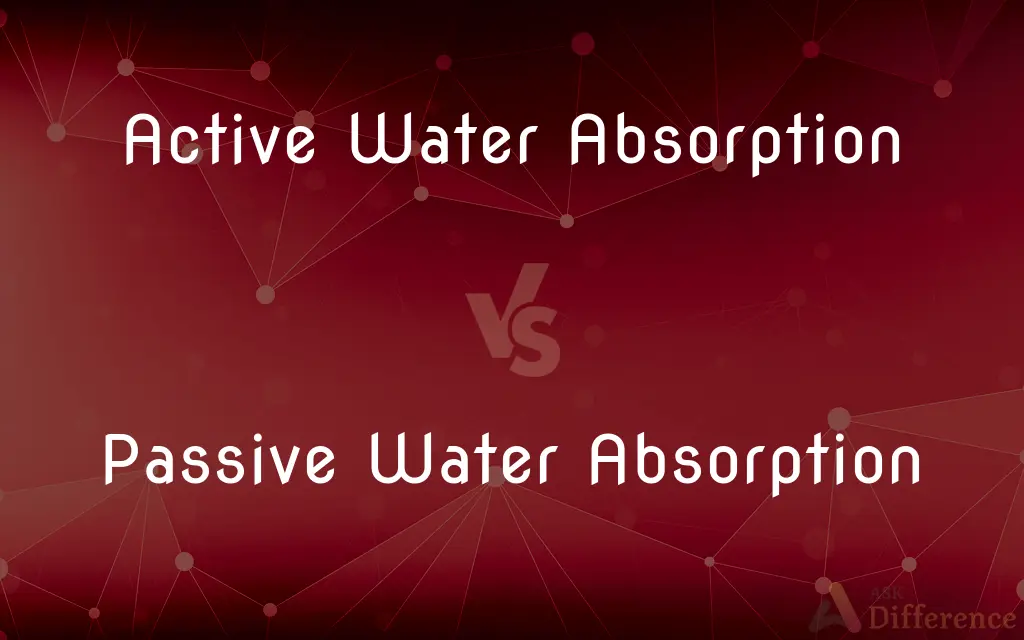Active Water Absorption vs. Passive Water Absorption — What's the Difference?
By Tayyaba Rehman & Fiza Rafique — Published on March 2, 2024
Active water absorption involves energy expenditure to uptake water against gradients, while passive absorption relies on soil moisture and transpiration pull.

Difference Between Active Water Absorption and Passive Water Absorption
Table of Contents
ADVERTISEMENT
Key Differences
Active water absorption is a process requiring energy, usually ATP, to move water from areas of low concentration to high concentration within a plant. This mechanism often involves the active transport of ions into the root cells, creating a concentration gradient that water follows osmotically.
Passive water absorption, on the contrary, does not require direct energy expenditure. It relies on the physical properties of water and the cohesive and adhesive forces within the plant's xylem. The transpiration stream, driven by the evaporation of water from the leaves, creates a tension that pulls water up through the plant from the roots.
The active absorption process is crucial in situations where the water potential in the soil is lower than in the plant, necessitating energy-dependent mechanisms to ensure water uptake. It's also significant when transpiration rates are low and cannot generate enough pull for water movement.
Passive absorption dominates under normal conditions, where there is adequate soil moisture, and the transpiration rate is high. This process is efficient and conserves energy for the plant, leveraging the natural properties of water and plant structure.
Both methods ensure that plants receive the necessary water to perform photosynthesis, grow, and transport nutrients, while they operate under different environmental conditions and plant needs. Understanding these mechanisms helps in agricultural practices, ensuring optimal watering strategies for crops.
ADVERTISEMENT
Comparison Chart
Energy Requirement
Requires energy (ATP)
Does not require direct energy expenditure
Driving Force
Ion gradient and osmotic pressure
Cohesion-tension theory and transpiration pull
Environmental Conditions
Beneficial in low soil moisture
Effective in high soil moisture and transpiration
Dependency
On plant's metabolic activities
On environmental conditions and physical properties
Role in Plant
Supplements passive absorption, especially under stress conditions
Primary method of water uptake under normal conditions
Compare with Definitions
Active Water Absorption
The process where plants use energy to absorb water.
Roots actively absorb water when soil moisture is low.
Passive Water Absorption
Does not require energy expenditure from the plant.
Passive absorption utilizes the cohesion-tension theory for water movement.
Active Water Absorption
Involves the active transport of ions to facilitate water movement.
The plant's roots actively transport ions to assist in water uptake.
Passive Water Absorption
A method relying on natural physical forces for water uptake.
Plants passively absorb water through root pressure.
Active Water Absorption
Is essential for water uptake under stressful conditions.
During drought, active water absorption becomes crucial for survival.
Passive Water Absorption
Driven by transpiration pull and cohesion of water molecules.
Passive water absorption is efficient during high transpiration.
Active Water Absorption
Can operate independently of transpiration.
Active absorption ensures water uptake at night when transpiration rates are low.
Passive Water Absorption
Predominant under normal environmental conditions.
On a sunny day, plants primarily rely on passive water absorption.
Active Water Absorption
Relies on the plant's metabolic energy.
Plants expend ATP for active water absorption.
Passive Water Absorption
Dependent on soil moisture and atmospheric conditions.
Adequate soil moisture facilitates passive water absorption.
Common Curiosities
How does passive water absorption work?
Passive water absorption works through the natural physical properties of water, utilizing transpiration pull and cohesion without needing direct energy expenditure from the plant.
What drives passive water absorption?
Passive water absorption is driven by the cohesive and adhesive properties of water molecules, along with the transpiration pull created by water evaporation from leaves.
What is active water absorption?
Active water absorption is a plant's process of using energy to uptake water, especially under conditions where passive methods are insufficient.
Can a plant survive on passive water absorption alone?
Yes, under ideal conditions with adequate soil moisture and high transpiration rates, plants can rely solely on passive water absorption.
What role does soil moisture play in water absorption?
Soil moisture is crucial, as it determines the availability of water for passive absorption and the need for active absorption mechanisms.
What is the role of ATP in active water absorption?
ATP provides the energy required for the active transport of ions, which facilitates water movement into the plant against osmotic gradients.
Does active water absorption occur at night?
Yes, active water absorption can occur at night, providing plants with necessary water when transpiration rates are low.
Why do plants need active water absorption?
Plants need active water absorption to ensure water uptake under conditions of low soil moisture or when transpiration is not sufficient to drive water uptake.
How do environmental conditions affect these processes?
Environmental conditions such as soil moisture, humidity, and temperature can significantly influence the balance between active and passive water absorption in plants.
Can transpiration affect water absorption?
Yes, transpiration creates a pull that facilitates passive water absorption but can also necessitate active absorption when rates are low.
How do plants regulate these processes?
Plants regulate water absorption through hormonal signals and adjusting root permeability, responding to internal needs and external conditions.
Is active water absorption energy-efficient?
No, active water absorption requires energy, making it less energy-efficient compared to passive absorption but necessary under certain conditions.
What is the significance of the ion gradient in active absorption?
The ion gradient created by active transport of ions into root cells generates an osmotic pressure that drives water into the plant.
How does the cohesion-tension theory apply to passive absorption?
The cohesion-tension theory explains how water molecules stick together and are pulled up through the plant's xylem as water evaporates from the leaves.
Are there any plants that rely more on active absorption?
Plants in arid environments or with high salt concentrations in the soil may rely more on active water absorption to overcome harsh conditions.
Share Your Discovery

Previous Comparison
Manifest Function vs. Latent Functions
Next Comparison
Google Drive vs. Amazon Cloud DriveAuthor Spotlight
Written by
Tayyaba RehmanTayyaba Rehman is a distinguished writer, currently serving as a primary contributor to askdifference.com. As a researcher in semantics and etymology, Tayyaba's passion for the complexity of languages and their distinctions has found a perfect home on the platform. Tayyaba delves into the intricacies of language, distinguishing between commonly confused words and phrases, thereby providing clarity for readers worldwide.
Co-written by
Fiza RafiqueFiza Rafique is a skilled content writer at AskDifference.com, where she meticulously refines and enhances written pieces. Drawing from her vast editorial expertise, Fiza ensures clarity, accuracy, and precision in every article. Passionate about language, she continually seeks to elevate the quality of content for readers worldwide.
















































